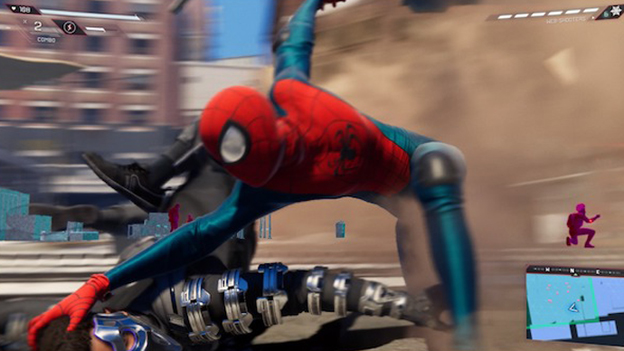A Superhero Story Only a Game Could Tell
The gold standard for superhero video games was set by Batman: Arkham Asylum in 2009 when it showed the world it was possible to create an experience through tone and mechanics that allows players to feel like they are embodying an iconic hero. In 2018, Insomniac Games evoked the same sensation with Marvel’s Spider-Man on the PlayStation 4. As impressive as that was, they’ve now set a new gold standard with the release of Spider-Man: Miles Morales. This game doesn’t merely allow players to feel like Spider-Man. It also allows them to feel like Miles Morales.
Miles’ personality radiates from nearly every aspect of Spider-Man: Miles Morales. We see his presence when he is engaged in bold, high-flying acrobatics just as we see him in less graceful moments where he fumbles with a web or slips to the ground. The game evokes “Miles Morales” even more than it evokes “Spider-Man” in its UI, menus, music, story, and gameplay. The result is a game with an identity unlike anything else on the market. It’s quite a feat when you consider how much of the game is modeled after its predecessor. For all the similarities, Spider-Man: Miles Morales is distinct and it’s the game’s differences that make it so remarkable.
One of the differences that might be leveraged against Spider-Man: Miles Morales , perhaps unfairly, is the game’s diminutive length. If you are steadfast in the belief that a game’s value is inextricably linked to playtime, Spider-Man: Miles Morales will seem like a rip-off at full price. While it is indeed possible for you to beat the game in a single day off and still have time to spare, I’d wager that would be true of most titles if stuffing games to the brim with filler hadn’t become such a common practice.

Spider-Man: Miles Morales doesn’t waste time bringing players into its narrative and gameplay, practically doing both at the same time. If you like, you can choose to watch a brief recap of the relevant parts of Marvel’s Spider-Man without really spoiling the first game but it’s not at all necessary. Even factoring the time it takes to watch that cutscene, you will take control of Miles, mid-swing ,within a couple of minutes. Moments later, Miles (who has rendezvoused with his brotherly Spider-mentor, Peter Parker) clumsily sets Rhino free. In the ensuing few minutes where Rhino tears through the city, players will experience combat, tension, comedy, drama, quips, explosions, tenderness, and new developments. They’ll also save a baby. Somehow, the pacing and concision isn’t the noteworthy part. That honor is reserved for the fact that this sequence so seamlessly blends cutscene and gameplay that it becomes something greater than either. In terms of storytelling, it conveys everything you’d expect from a conventional cutscene, but there’s a real sense that you’re part of that story. And as you wield Spider-Man’s great power through the sequence, you might just feel a great responsibility for the events that unfold. It is an effective method for drawing you into the game.
In that sequence, Miles Morales mysteriously conjures previously untapped bioelectric Spider-powers. That is a big moment in its own right but it’s followed by Peter telling Miles that he’ll be leaving the city for a bit which means Miles will temporarily be New York City’s only Spider-Man. All of a sudden, Miles is in charge of protecting New York. It’s a huge responsibility, assuming you ignore how many Marvel superheroes are canonically present in New York City’s 302.6 square miles. Jokes aside, the mantle of the “friendly neighborhood Spider-Man” carries more narrative weight in Spider-Man: Miles Morales because while Miles is undeniably a friendly Spider-Man, he is very new to the neighborhood of Harlem.
Miles moved into his abuela’s old Harlem apartment with his mom after the tragic events of Marvel’s Spider-Man. It’s a period of adjustment for him that is further complicated by his newly developed Spider powers. Spider-Man: Miles Morales avoids the pratfalls of an origin story by opting to tell a story of transition and growth, instead. The game is grounded in the culture, past, and interests that make Miles who he is. The choice to revolve around these facets of his personality rather than his radioactive spider blood feels like the right direction. It’s compelling to watch Miles fold the burgeoning truths of his secret identity into the established framework of his core identity. It never comes across like Miles is living a double life, either. Sure, he has a pretty substantial secret, but he’s still Miles — a person who plays a heroic and essential role in people’s lives regardless of whether or not he is adorned in one of the game’s many different Spider-Man costumes.
The focus on Miles as a person rather than a superhero is made evident by his relationship with his best friend and confidante, Ganke. Ganke is aware of Miles’ secret and doesn’t treat him any differently. In some ways, this means Ganke is also a crime fighter through virtue of his friendship, even if that’s not the first impression you might have of him which is more or less my point. Ganke would be Ganke even if he had no idea what Miles was up to, but because he is aware of his best friend’s life as a superhero, he develops a crime-fighting app and does everything he can to help Miles hide his secret identity. His attitude is the same one I might have had in high school if a non-superhero best friend asked me to help study for an exam or sneak out of their parent’s house. It’s just what best friends do.
The crimefighting app is a bit like UberEats, except instead of a courier delivering tasty treats, it’s Spider-Man delivering justice. It is a good device to connect the character to the setting, and many of the quests initiated through it help develop the inhabitants of the open-world. It’s obviously a tool meant to give quests to the players but it doesn’t feel contrived and helps streamline the action. Spider-Man: Miles Morales offers a more focused story with fewer options in terms of open-world questing than the previous game, too. With fewer ways to deviate from the main scenario, the player’s attention is more likely to be directed toward the narrative’s emotional through line. I do not know if Insomniac Games designed the game this way in an effort to save resources or as a way to exercise better control over the experience and pace, but the outcome is a positive one.

This pacing may be entirely unlike that of Marvel’s Spider-Man, but the shared DNA in the gameplay between that game and is always readily apparent. Despite some changes, including the electric powers unique to Miles Morales, a player who has only played the first game should, theoretically, be able to pick up a controller halfway through this one and find their bearings without issue. I almost suspected that the developers wanted players to experience Spider-Man: Miles Morales as a follow up to Marvel’s Spider-Man when the game opened to a segment that could pose challenges to newcomers of the series or genre, regardless of difficulty setting. That suspicion was alleviated in the subsequent tutorial session which gives players a chance to practice the game’s controls consequence-free as Peter Parker instructs Miles via holograms on the finer aspects of fighting, web-slinging, and delivering sick burns.
Spider-Man: Miles Morales does change things up to an extent. Miles has access to a different array of gadgets and possesses a few different abilities than Peter Parker. The game also keeps things fresh with stealth options and unique boss encounters. Even if it didn’t, the shared DNA probably wouldn’t come across as a problem because the gameplay was so amazing in the first place. Many encounters take place in large areas that encourage the use of Spider-Man’s mobility options. There’s an incredible range of abilities in Spider-Man’s toolkit, too, so players will be able to carve out their own style. I always felt as though I had a lot of control over the battles and enjoyed the ability to inhibit enemies with webs so I could concentrate on specific targets or tasks. There isn’t any single ability or maneuver in Spider-Man: Miles Morales that is challenging to execute so getting better means learning when and how to use the different tools at your disposal. A lot of enemies in the game are of the “generic bad dudes with guns” persuasion, but the combat and level design ensure that encounters remain engaging. A leveling system that provides palpable bonuses rather than indiscernible numerical increases to stats rounds out the experience.

In fewer words, what I’m trying to convey is that fighting baddies as Miles Morales is rewarding and feels badass. Beyond that, it looks badass. While reviewing footage of my time playing the game, I realized that combat is utterly watchable. This is especially true during the sequences that blend combat into narrative. It might sound bold, but I believe Spider-Man: Miles Morales is a cinematic experience that is just as watchable as an actual Spider-Man film.
To that end, Spider-Man: Miles Morales might be the best of two worlds. It is short for a video game, but that means it’s easier to fit into a busy schedule and that sort of approachability has merit. It’s also not beholden to the limited runtime of a film which means it can use storytelling techniques that are unique to the video game medium. Spider-Man: Miles Morales constantly deepens the game’s world and lore in ways that other media couldn’t. A movie wouldn’t depict Spider-Man listening to a J. Jonah Jameson broadcast on his way to a crime scene nor would it show Miles Morales walking about his apartment reflecting on every sentimental object he comes across. There’s an intimacy that develops throughout these moments and it becomes second nature to care about Miles and the people in his life. The game’s ability to be dense yet accessible is also used to accentuate the subtext. Spider-Man: Miles Morales has a lot to say and it uses every available resource to communicate its messages and themes. Like Miles himself, it is earnest. Among other things, it depicts societal issues in an honest, digestible, and unabashed way. I said before that Spider-Man: Miles Morales establishes a new gold standard for superhero games but that’s not the only bar it’s moving. There are multiple bars set by Spider-Man: Miles Morales that developers should attempt to clear in future products.
RATING OUT OF 5 RATING DESCRIPTION 5.0 Graphics
Looks beautiful on the PS4. I’m from New York, and the detailed textures, lighting effects, and dirty snow had me missing it on a sensory level 5.0 Control
Couldn’t ask for anything better. There’s so much precision over Spider-Man’s actions, and it’s thrilling to swing about beating up baddies 5.0 Music / Sound FX / Voice Acting
A fitting soundtrack from a composer who has experience in the superhero genre. Voice acting is exceptional 5.0 Play Value
Short and sweet. The kind of game that you love to play but could also be enjoyably watched 5.0 Overall Rating – The Best
Not an average. See Rating legend below for a final score breakdown.
| Review Rating Legend | |||
|---|---|---|---|
| 0.1 – 1.9 = Avoid | 2.5 – 2.9 = Average | 3.5 – 3.9 = Good | 4.5 – 4.9 = Must Buy |
| 2.0 – 2.4 = Poor | 3.0 – 3.4 = Fair | 4.0 – 4.4 = Great | 5.0 = The Best |
Game Features:
